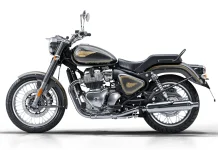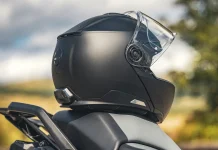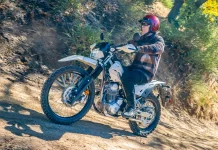BMW S 1000 RR Review
Apparently an old dog can come up with a new trick. That’s not to say that BMW is an “old dog,” but certainly they’ve been around for a long time and have tended to be something of an acquired taste. Well hang on to your helmet, because if you’ve got any pre-conceived negative notions about BMW motorcycles, they’re about to wheelie over the horizon.
In 2004, BMW management realized they needed to revamp their image and develop a dynamic brand representation more akin to their range of cars–they needed a motorcycle equivalent of the M3. The end result is the freshly minted 2010 BMW S 1000 RR superbike. BMW hasn’t totally abandoned its slight quirkiness, however, as clearly not everyone will embrace the asymmetric split-face aesthetic of the new 2010 BMW S 1000 RR superbike. But that unique look does make a powerful statement, doesn’t it?
But, love or loathe the looks of the new machine, one thing that nobody will dispute is whether the motorcycle works or not. I could waffle on, theorizing about 193 crankshaft horsepower, a wet weight of 455 pounds (with ABS), and the excellent race-derived handling from the 43mm male-slider forks and Sachs rear shock, blah blah blah; but frankly, having just come off track on the new Beemer, my mind is such an absolute whirl of superlatives I’ll leave the technical specs for the box at the foot of this page. I’ll try and avoid the clichés, but no kidding, BMW’s new S 1000 RR is absolutely, sincerely, the real deal.
The across-the-frame four cylinder engine is conventional enough on paper, but in the real world BMW’s interpretation of the ubiquitous layout is spectacular. The S 1000 RR ride-by-wire throttle connection has plenty of feel, the motor is vibrationless throughout the rev range, and it provides seamless, colossal power that appears smoothly from idle and builds inexorably through to the 14,000 rpm redline. Restrained as necessary at any given moment by a complex electronics package, the new 2010 BMW S 1000 RR simply works very, very well.
Launched at the highly technical, new Autódromo Internacional do Algarve circuit near Portimao, Portugal, I quickly realized that BMW’s new 2010 S 1000 RR superbike was in its element. Rounding the final sweeping turn at around 100 mph, dropping into the bowl and then straightening out for the short uphill climb on to the main straight was completely addictive. Cresting over the subsequent rise at around 150 mph with the front wheel pawing the air was a mainline endorphin rush that had me craving for more after the first hit. The front wheel would then touch back down and I’d barrel along the straight, flat on the tank, with the engine howling up to the flicker of the shift-light. Clicking into fifth and then sixth gear were effortlessly precise, clutchless upshifts that engaged smoothly and seamlessly without having to come off the throttle. I’ve already waxed lyrical about BMW’s gear shift assistant when I sampled it on the BMW K 130 0S, but on the superbike–and a busy circuit like Portimao–it’s even more valuable.
Another journalist friend commented to me that BMW’s Gear Shift Assistant works better than the competition quickshifter fitted to his race bike…an impressive accolade, indeed. Essentially BMW’s version cuts the ignition for a split second enabling clutchless upshifts without the need to chop the throttle–especially useful exiting some of Portimao’s slow corners that required upshifting quickly and smoothly as the track unwound.
Cresting over the hill at the end of the straight it was then time to think about braking; and with full ABS keeping me safe I felt braver on the brakes at wicked high speed than I ever have before–and this was on the 2010 BMW S 1000 RR street compound Metzeler Racetech tires. Clicking quickly down four gears for Turn 1, the slipper clutch managed the back torque well enough that the chassis didn’t get upset at all.
The electronics on the 2010 BMW S 1000 RR are impressive and four modes flavor the interference from mild to wild. I started the ride in the kindest mode: Rain. It restricts the motor to only(!) 150 horsepower and sets the traction control and ABS on their most intrusive setting. Bank angle sensors as well as speed sensors on both wheels keep the computer well-enough informed to help it make the split-second decisions necessary to keep you safe. After three laps I switched up to the next mode: Sport. This is accomplished by pressing the right thumb Mode button above the starter and then flipping the clutch to confirm the change. The active mode is then shown in small letters within the LCD display next to the speed display and digital gear indicator.
Sport, Race, and Slick modes allow full engine horsepower to be released, but the traction control dilutes the power based on pre-set criteria that include lean angle and throttle position. Exiting the gnarly, tight hairpin at Portimao with the bike leaned fully over, in Sport mode the power wasn’t quite aggressive enough for my taste, and then as the bike straightened up (less than 42 degrees bank angle) the power would then start to flood in hard. For the track, and my riding style, it was a little too intrusive and almost felt like the old two-stroke type of powerband where the engine would come on song around 6,000 rpm and suddenly take off. I quickly realized it wasn’t a narrow engine powerband or a ‘cammy’ motor, but the electronic aid interfering. It became fun to set the throttle at a constant position and then bring the power in by lifting the bike upright, or lessen the power by inducing more lean angle. You can literally play with the power delivery that way–cool. For all sessions beyond the first–and as I got used to the highly technical track–I moved on to Race and then briefly Slick modes (Slick being for use with race compound tires) and again, those modes simply allowed less intrusion of the electronic aids.
Although I only rode the 2010 BMW S 1000 RR on track, I can easily see how Sport and Rain would work well on the street; we’ll have to check that out at a later date to confirm. There’s no wheelie control per se, however with the above mentioned exploits on the front straight as I crested over the hill in fourth, the traction control would detect the front wheel marginally slowing compared to the rear, and the resultant slight retardation of power would bring the front back down. If you bring the wheel up too quickly, the front won’t slow down fast enough for the traction control to cut in, so be careful–as I said, it’s not wheelie control. In Race mode, I didn’t notice the electronic aid. However, I’m sure I was being helped as the bike was so rideable, and the realization that there was a reliable safety net should I get things really wrong filled me with confidence on the BMW S 1000 RR.
So the end result of BMW’s first foray into the harshly competitive world of superbikes is a BMW S 1000 RR that seems to deliver as promised. The electronic wizardry will be a boon to most riders, and at the Portimao launch the proof seemed to come from the fact that over several days and almost 100 journalists from around the world thrashing around a highly technical track–there wasn’t a single crash. Secondly, at the end of the day, the street compound Metzeler Racetech tires were clean and evenly worn–not fried and balled up the way tires usually finish at the end of an aggressive track session.
Kudos to BMW on the 2010 S 1000 RR. They’ve done their homework and produced the 2010 BMW S 1000 RR to check all the necessary superbike class boxes. They deserve to be successful with this motorcycle and I’m convinced they will be.
2010 BMW S 1000 RR Specs
>> 999 cc
>> 193 hp @ 13,000 rpm
>> 83 lb/ft @ 9,750 rpm
>> 14,200 rpm redline
>> Dry weight of 404 lb.
>> Slipper clutch
>> Multi disc wet clutch
>> Race ABS & Dynamic Traction Control
Photos by Kel Edge
If you have any questions for Arthur on the new BMW S 1000 RR please feel free to post your comments below and he will answer as soon as possible





